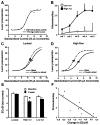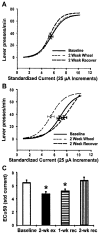Voluntary running-wheel exercise decreases the threshold for rewarding intracranial self-stimulation
- PMID: 22845707
- PMCID: PMC4433312
- DOI: 10.1037/a0029149
Voluntary running-wheel exercise decreases the threshold for rewarding intracranial self-stimulation
Abstract
Physical exercise has mood-enhancing and antidepressant properties although the mechanisms underlying these effects are not known. The present experiment investigated the effects of prolonged access to a running wheel on electrical self-stimulation of the lateral hypothalamus (LHSS), a measure of hedonic state, in rats. Rats with continuous voluntary access to a running wheel for either 2 or 5 weeks exhibited dramatic leftward shifts in the effective current 50 (ECu50; current value that supports half of maximum responding) of their LHSS current-response functions compared to their baselines, indicating a decrease in reward threshold, whereas control rats current-response functions after 2 or 5 weeks were not significantly different from baseline. An inverse correlation existed between the change in ECu50 from baseline and the amount an animal had run in the day prior to LHSS testing, indicating that animals that exhibited higher levels of running showed a more robust decrease in LHSS threshold. We conclude that long-term voluntary exercise increases sensitivity to rewarding stimuli, which may contribute to its antidepressant properties.
Figures


References
-
- Babyak M, Blumenthal JA, Herman S, Khatri P, Doraiswamy M, Moore K, Krishnan KR. Exercise treatment for major depression: Maintenance of therapeutic benefit at 10 months. Psychosomatic Medicine. 2000;62:633–638. - PubMed

